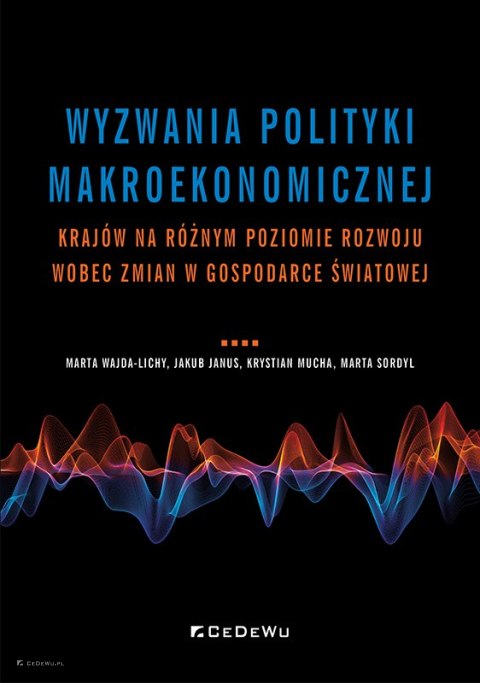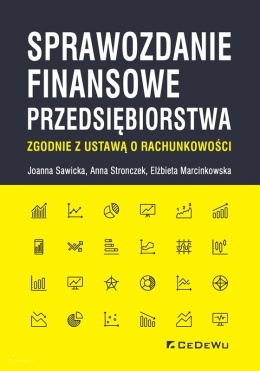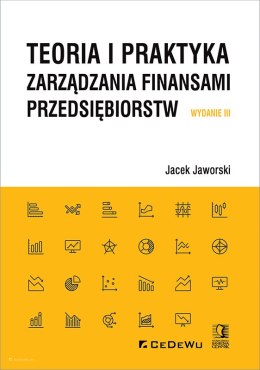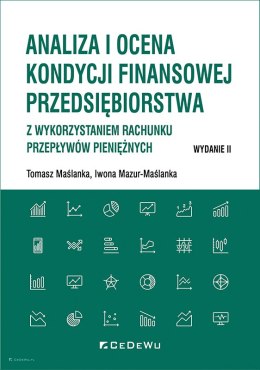-
Koszyk jest pusty
-
x

-
Koszyk jest pusty
-
x
- Kategorie
-
Wyzwania polityki makroekonomicznej krajów na różnym poziomie rozwoju wobec zmian w gospodarce światowej

Monografia przedstawia wyzwania w zakresie polityki makroekonomicznej, z którymi mierzą się kraje na różnym poziomie rozwoju w dobie dynamicznych zmian we współczesnym świecie. Poruszana problematyka odnosi się również do nieoczekiwanego sprawdzianu, jakiemu zostały poddane gospodarki w okresie kryzysu wywołanego pandemią COVID-19.
| Kod kreskowy | |
| ISBN | 978-83-8102-564-5 |
| EAN | 9788381025645 |
Monografia przedstawia wyzwania w zakresie polityki makroekonomicznej, z którymi mierzą się kraje na różnym poziomie rozwoju w dobie dynamicznych zmian we współczesnym świecie. Poruszana problematyka odnosi się również do nieoczekiwanego sprawdzianu, jakiemu zostały poddane gospodarki w okresie kryzysu wywołanego pandemią COVID-19. Kolejne części publikacji odpowiadają na pytania:
- W jaki sposób rozwój technologii cyfrowych wpływa na przeobrażenia handlu międzynarodowego?
- Co decyduje o podatności gospodarek wschodzących na wahania na światowych rynkach finansowych?
- Czy propozycje zmian strategii polityki pieniężnej stanowią istotną alternatywę dla standardowych praktyk banków centralnych?
- Jak polityka rynku pracy może przeciwdziałać ekonomicznym i społecznym skutkom zakłóceń gospodarczych?
Autorzy, pracownicy Katedry Makroekonomii Uniwersytetu Ekonomicznego w Krakowie, czerpią z doświadczeń szerokiej grupy gospodarek, podejmują najnowsze wątki teoretyczne i empiryczne oraz formułują wnioski dla polityki makroekonomicznej w zakresie jej celów i narzędzi w nowej, postpandemicznej rzeczywistości.
Wstęp 9
Rozdział 1
Handel zagraniczny w dobie cyfryzacji - implikacje dla polityki handlowej krajów na średnim i wysokim poziomie rozwoju - Marta Wajda-Lichy 15
1.1. Definiowanie i pomiar handlu zagranicznego w dobie cyfryzacji 17
1.2. Obszary wykorzystania technologii cyfrowej w handlu zagranicznym i jej wpływ na kształt globalnego łańcucha wartości 20
1.3. Udziały krajów na średnim i wysokim poziomie rozwoju w handlu zagranicznym wykorzystującym technologię cyfrową 24
1.4. Wpływ cyfryzacji na rozkład wartości dodanej między krajami rozwiniętymi i rozwijającymi się 27
1.5. Polityka handlowa i regulacje w dobie cyfryzacji 32
1.6. Nowy wymiar regionalnych porozumień handlowych w dobie cyfryzacji 39
Bibliografia 46
Rozdział 2
Czy gospodarki wschodzące mierzą się z nową odsłoną problemu „grzechu pierworodnego"? - Jakub Janus 49
2.1. Hipoteza „grzechu pierworodnego" na przełomie XX i XXI wieku 51
2.2. Nowa odsłona zjawiska „grzechu pierworodnego" w gospodarkach wschodzących 55
2.2.1. Istota i przyczyny problemu 55
2.2.2. Kanał finansowy kursu walutowego 58
2.2.3. Wpływ na politykę makroekonomiczną 61
2.3. Ryzyko kraju a kurs dolara amerykańskiego - analiza empiryczna 64
2.3.1. Dane i specyfikacja modeli empirycznych 64
2.3.2. Podstawowe modele panelowe 69
2.3.3. Interakcje kursów walutowych i globalnych miar ryzyka 72
2.3.4. Rola struktury rynków obligacji skarbowych 75
Bibliografia 79
Aneks 82
Rozdział 3
Strategie przeciętnej stopy inflacji oraz tymczasowego celu w postaci poziomu cen jako reakcja na deflacyjne tendencje w gospodarce światowej - Krystian Mucha 85
3.1. Podstawowe różnice między strategiami IT i PLT 87
3.2. Ewolucja argumentów na rzecz strategii PLT 89
3.2.1. Dyskusja teoretyczna do lat 90. XX wieku 89
3.2.2. „Darmowy lunch" L.E.O. Svenssona 91
3.2.3. Reakcje na argument Svenssona 93
3.2.4. Problem dolnej granicy nominalnych stóp procentowych 94
3.3. Współczesne propozycje przejścia na strategię PLT 97
3.3.1. Strategia czasowego celu w postaci poziomu cen 97
3.3.2. Strategia celu w postaci przeciętnej stopy inflacji 101
Bibliografia 105
Rozdział 4
Narzędzia i skuteczność polityki rynku pracy w czasie kryzysu - doświadczenia krajów Ameryki Łacińskiej - Marta Sordyl 109
4.1. Cele i narzędzia polityki rynku pracy 110
4.2. Wpływ PRP na rynek pracy 115
4.2.1. Narzędzia oddziałująca na liczbę miejsc pracy 115
4.2.2. Polityka wspierania aktywności zawodowej i zatrudnialności 118
4.2.3. Poprawa jakości dopasowania pracownik-stanowisko 120
4.2.4. Zapewnienie dochodu w okresach braku zatrudnienia 121
4.3. Polityka rynku pracy w czasie kryzysu - przypadek pandemii COVID-19 124
4.3.1. Wpływ pandemii COVID-19 na rynki pracy 125
4.3.2. Skutki pandemii COVID-19 dla krajów Ameryki Łacińskiej 131
4.3.3. Narzędzia antykryzysowe i ich wpływ na rynki pracy w krajach regionu 135
Bibliografia 142
Zakończenie 145
Spis tabel 149
Spis rysunków 151
Recenzenci:
Dr hab. Joanna Bogołębska, prof. Uniwersytetu Łódzkiego
Dr hab. Sylwia Pangsy-Kania, prof. Uniwersytetu Gdańskiego
Aaronson S. (2019). What are we talking about when we talk about digital protectionism? World Trade Review, 18(4), 541-577.
Abeliansky A.L., Hilbert M. (2017). Digital technology and international trade: is it the quantity of subscriptions or the quality of data speed that matters? Telecommunications Policy, 41(1), 35-48.
Adato M., Hoddinott J. (2010). Conditional cash transfers in Latin America. John Hopkins University Press, Baltimore.
Adrian T., Crump R.K., Moench E. (2013). Pricing the term structure with linear regressions. Journal of Financial Economics, 110(1), 110-138. https://doi.org/10.1016/j.jfineco.2013.04.009.
Aizenman J., Jinjarak Y., Park D., Zheng H. (2021). Good-bye original sin, hello risk on-off, financial fragility, and crises? Jour-nal of International Money and Finance, 117, 102442. https://doi.org/10.1016/j.jimonfin.2021.102442.
Almeida R., Arbelaez J., Honorati M., Kuddo A., Lohman T., Ovadiya M., Pop L., Sanchez Puerta M.L., Weber M. (2012). Im-proving Access to Jobs and Earning Opportunities. The Role of Activation and Graduation Policies in Developing Countries. Social Protection & Labor Discussion Paper no. 1204, March.
Amano R., Ambler S. (2008). Inflation targeting, price level targeting and the zero lower bound on nominal interest. New Per-spectives on Monetary Policy conference, CREI, Bank of Canada, October 10-11.
Amarante V., Brun M. (2016). Cash transfers in Latin America. Effects on poverty and redistribution. WIDER Working Paper 2016/136, United Nations University.
Ambler S. (2009). Price-level targeting and stabilization policy: a survey. Journal of Economic Surveys, Vol. 23, No. 5.
Arslanalp S., Tsuda T. (2014). Tracking global demand for advanced economy sovereign debt. IMF Economic Review, 62(3), 430-464. https://doi.org/10.1057/imfer.2014.20.
Avdjiev S., Bruno V., Koch C., & Shin H.S. (2019). The Dollar Exchange Rate as a Global Risk Factor: Evidence from Invest-ment. IMF Economic Review, 67(1), 151-173. https://doi.org/10.1057/s41308-019-00074-4.
Baker S.R., Bloom N., Davis S.J. (2016). Measuring economic policy uncertainty. Quarterly Journal of Economics, 131(4), 1593-1636. https://doi.org/10.1093/qje/qjw024.
Baldwin R. (2016). The Great Convergence, Harvard University Press, Cambridge (MA).
Baldwin R., Low P. (2009). Multilateralizing Regionalism: Challenges for the Global Trading System, Cambridge University Press. eBook.
Barnett R., Engineer M. (2000). When Is Price-Level Targeting a Good Idea?. "Price Stability and the Long-Run Target for Mone-tary Policy", Proceedings of a seminar held by the Bank of Canada, June.
Barro R.J., Sala-i-Martin X. (2004). Economic Growth. The MIT Press, 2nd Edition, Cambridge, Massachusetts, London, England.
Batini N., Yates T. (2003). Hybrid inflation and price level targeting. Journal of Money, Credit and Banking 35 (3): 283-300.
Bauducco S., Caputo R. (2010). Price level targeting and inflation targeting: a review. Central Bank of Chile Working Papers, No. 601.
Baumeister C., Korobilis D., Lee T.K. (2020). Energy Markets and Global Economic Conditions. The Review of Economics and Statistics, 1-45. https://doi.org/10.1162/rest_a_00977.
Berens S., Kemmerling A. (2019). Labor Divides, Informality, and Regulation: The Public Opinion on Labor Law in Latin Ameri-ca. Journal of Politics in Latin America, 11(1), 23-48. https://doi.org/10.1177/1866802X19843362
Berg C., Johnung L. (1998). Pioneering price level targeting: the Swedish experience 1931-1937. SSE/EFI Working Paper Series in Economics and Finance, No. 290.
Bernanke B.S. (2017a). Temporary price-level targeting: An alternative framework for monetary policy. Brookings.edu, October 12.
Bernanke B.S. (2017b). Monetary policy in a new era. Brookings Institution, October 2.
Bernanke B.S. (2019). Evaluating lower-for-longer policies: Temporary price-level targeting. Brookings.edu, February 21, https://www.brookings.edu/blog/ben-bernanke/2019/02/21/evaluating-lower-for-longer-policies-temporary-price-level-targeting/, dostęp na 25.06.2021.
Bernanke B.S., Kiley M.T., Roberts J.M. (2019). Monetary Policy Strategies for a Low-Rate Environment. Finance and Econom-ics Discussion Series No. 2019-009, Federal Reserve Board, Washington, D.C.
Bernard A.B., Fort T.C. (2015). Factoryless goods producing firms, American Economic Review, 105(5), 518-52.
Bernoth K., Herwartz H. (2021). Exchange Rates, Foreign Currency Exposure and Sovereign Risk. Journal of International Mon-ey and Finance, 102454. https://doi.org/10.1016/j.jimonfin.2021.102454.
Bertranou F., Casalí P., Velasco J.J. (2019). The future of social protection in Latin America in a context of accelerated changes. W: Cruz-Martínez, G. (ed.). Welfare and Social Protection in Contemporary Latin America. Routledge, New York.
Blanchard O., Dell'Ariccia G., Mauro P. (2010). Rethinking macroeconomic policy. Journal of Money, Credit and Banking 42: 199-215.
Bogołębska J. (2020). Stabilność międzynarodowego system walutowego. Problemy i kierunki reformy. Łódź, Wydawnictwo Uni-wersytetu Łódzkiego.
Böhm J., Filacek J., Kubicova I., Zamazalova R. (2011). Price-Level Targeting - A Real Alternative to Inflation Targeting? Re-search and Policy Notes 2011/01, Czech National Bank.
Borri N. (2018). Local currency systemic risk. Emerging Markets Review, 34, 111-123. https://doi.org/10.1016/j.ememar.2017.11.003
Bown C.P. (2019). The 2018 US-China trade conflict after forty years of special protection, China Economic Journal, 12(2).
Brainard L. (2017). Rethinking Monetary Policy in a New Normal. Panel on Monetary Policy "Rethinking Macroeconomic Policy," a conference sponsored by the Peterson Institute for International Economics, Washington D.C., October 12.
Brown A.J.G., Koettl J. (2012). Active Labor Market Programs: Employment Gain or Fiscal Drain?. IZA Discussion Paper No. 6880, September.
Bruno V., Shin H.S. (2015). Capital flows and the risk-taking channel of monetary policy. Journal of Monetary Economics, 71, 119-132. https://doi.org/10.1016/j.jmoneco.2014.11.011
Budianto F., Nakata T., Schmidt S. (2020). Average Inflation Targeting and the Interest Rate Lower Bound. BIS Working Papers No. 852, April.
Burda M., Hunt J. (2011). What Explains the German Labor Market Miracle in the Great Recession?. NBER Working Paper No. 17187, National Bureau for Economic Research, Cambridge, MA.
Burger J.D., Warnock F.E., Warnock V.C. (2012). Emerging local currency bond markets. Financial Analysts Journal, 68(4), 73-93. https://doi.org/10.2469/faj.v68.n4.4.
Busso M., Camacho J., Messina J., Montenegro G. (2020). The Challenge of Protecting Informal Households during the COVID-19 Pandemic: Evidence from Latin America. COVID Economics Vetted and Real-Time Papers, Issue 27, CEPR Press.
Caballero R., Kamber G. (2019). On the global impact of risk-off shocks and policy put frameworks. BIS Working Papers, 772.
Cahuc P., Carcillo S. (2011). Is Short-Time Work a Good Method to Keep Unemployment Down?. IZA Discussion Paper No. 5430, January.
Calvo G.A., Reinhart C.M. (2002). Fear of floating. Quarterly Journal of Economics, 117(2), 379-408. https://doi.org/10.1162/003355302753650274.
Card D., Kluve J., Weber A. (2018). What Works? A meta-analysis of recent active labor market program evaluations, Journal of European Economic Association, 16(3), 894-931. https://doi.org/10.1093/jeea/jvx028
Carstens A., Shin H.S. (2019). Emerging Markets Aren't Safe Yet. Foreign Affairs. Retrieved from https://www.foreignaffairs.com/articles/2019-03-15/emerging-markets-arent-out-woods-yet.
Cazes S., Verick S., Heuer C. (2009). Labour Market Policies in Times of Crisis. Employment Working Paper No. 35, International Labour Office, Geneva.
Cerutti E., Claessens S., Puy D. (2019). Push factors and capital flows to emerging markets: why knowing your lender matters more than fundamentals. Journal of International Economics, 119, 133-149. https://doi.org/10.1016/j.jinteco.2019.04.006.
Céspedes L.F., Chang R., Velasco A. (2004). Balance sheets and exchange rate policy. American Economic Review, 94(4), 1183-1193. https://doi.org/10.1257/0002828042002589.
Clarida R., Davis J., Pedersen N. (2009). Currency carry trade regimes: Beyond the Fama regression. Journal of International Money and Finance, 28(8), 1375-1389. https://doi.org/10.1016/j.jimonfin.2009.08.010.
Colander D.C., Landreth H. (2005). Historia myśli ekonomicznej, wyd. II, PWN, Warszawa.
Corrocher N., Malerba F., Montobbio F. (2007). Schumpeterian Patterns of Innovation in the ICT Field. Research Policy, 36, 418-432.
Cortes G., Jaimovic N., Nekarda C., Siu H. (2020). The Dynamics of Disappearing Routine Jobs: A Flows Approach. Labour Economics, 65(C). https://doi.org/10.1016/j.labeco.2020.101823
Côté A. (2007). Price-Level Targeting. Bank of Canada Discussion Paper 2007-8, August.
Cournède B., Moccero,D. (2009). Is there a Case for Price-level Targeting? OECD Economics Department Working Papers, No. 721, OECD Publishing.
Daly A. (2017). Beyond 'Hipster Antitrust': A Critical Perspective on the European Commission's Google Decision, European Competition and Regulatory Law Review, 1(3), 188-192.
David A., Pienknagura S., Roldos J. (2020). Labor Market Dynamics, Informality, and Regulations in Latin America. IMF Work-ing Paper WP/20/19, International Monetary Fund, January.
Dąbrowski M.A., Papież M., Śmiech S. (2020). Classifying de facto exchange rate regimes of financially open and closed econo-mies: A statistical approach. Journal of International Trade and Economic Development, 29(7), 821-849. https://doi.org/10.1080/09638199.2020.1748692.
De Backer K., Flaig D. (2017). The Future of Global Value Chains: Business as usual or "a new normal"? OECD Science, Tech-nology and Innovation Policy Paper, 41.
Dittmar R., Gavin W.T. (2000). What Do New-Keynesian Phillips Curves Imply for Price-Level Targeting?. Federal Reserve Bank of St. Louis Review, March/April.
Driscoll J.C., Kraay A.C. (1998). Consistent covariance matrix estimation with spatially dependent panel data. Review of Econom-ics and Statistics, 80(4), 549-559. https://doi.org/10.1162/003465398557825.
Du W., Schreger J. (2016). Local Currency Sovereign Risk. Journal of Finance, 71(3), 1027-1070. https://doi.org/10.1111/jofi.12389.
Duguay P. (1994). Some Thoughts on Price Stability versus Zero Inflation. Draft. Bank of Canada.
Durand C.D., Milberg W. (2020). Intellectual monopoly in global value chains. Review of International Political Economy, 27(2), 402-429.
Duval R., Loungani, P. (2019). Designing Labor Market Institutions in Emerging Market and Developing Economies: Evidence and Policy Options. IMF Staff Discussion Note SDN/19/04, International Monetary Fund.
ECLAC (2021). Financing for development in the era of COVID-19 and beyond. Special Report No. 10, ECLAC, Santiago.
ECLAC/ILO (2020). Employment Situation in Latin America and the Caribbean. Employment trends in an unprecedented crisis: policy challenges. United Nations Publications, Santiago, Chile, November.
ECLAC/ILO (2021). Decent work for platform workers in Latin America. Employment Situation in Latin America and the Carib-bean, no. 24, June.
Eggertsson G.B., Woodford M. (2003). The zero bound on interest rates and optimal monetary policy. Brooking Papers on Eco-nomic Activity 1: 139-211.
Eichengreen B., Hausmann R. (1999). Exchange rates and financial fragility. NBER Working Papers, 7418.
Eichengreen B., Hausmann R., Panizza U. (2007). Currency Mismatches, Debt Intolerance, and Original Sin: Why They Are Not the Same and Why It Matters. In Capital Controls and Capital Flows in Emerging Economies (pp. 121-170). https://doi.org/doi:10.7208/9780226184999-005.
Eichhorst W., Escudero V., Marx P., Tobin, S. (2010). The Impact of the Crisis on Employment and the Role of Labour Market Institutions. IZA Discussion Paper No. 5320, November.
Engel C., Park J. (2018). Debauchery and Original Sin: The Currency Composition of Sovereign Debt. NBER Working Papers, 24671. Retrieved from https://ideas.repec.org/p/nbr/nberwo/24671.html.
Escudero V. (2018). Are active labour market policies effective in activating and integrating low-skilled individuals? An interna-tional comparison, IZA Journal of Labor Policy, 7(1), 1-26 https://doi.org/10.1186/s40173-018-0097-5.
Escudero V., Kluve J., López Mourelo E., Pignatti, C. (2017). Active labour market programmes in Latin America and the Carib-bean: Evidence from a meta analysis. Ruhr Economic Papers, No. 715.
Escudero V., Liepman, H. (2021). Delivering income and employment support in times of COVID-19: Integrating cash transfers with active labour market policies. ILO Policy Brief, June.
Evenett S.J. (2019). Protectionism, state discrimination, and international business since the onset of the Global Financial Crisis, Journal of Interntional Business Policy, 2, 9-36.
Evenett S.J., Fritz J. (2021). Mapping policies affecting digital trade, University of St. Gallen Endowment for Prosperity through Trade and CEPR, https://www.rsis.edu.sg/wp-content/uploads/2021/06/Evenett-Fritz-Mapping-Digital-Trade-rev-27-March-2021.pdf.
Farhi E., Gourinchas P.-O., Rey H. (2011). Reforming the International Monetary System. Centre for Economic Policy Research.
Farhi E., Maggiori M. (2018). A model of the international monetary system. Quarterly Journal of Economics, 133(1), 295-355. https://doi.org/10.1093/qje/qjx031.
Ferencz J. (2019). The OECD Digital Services Trade Restrictiveness Index, http://dx.doi.org/10.1787/16ed2d78-en.
Ferencz J., Gonzales F. (2019). Barriers to trade in digitally enabled services in the G-20, OECD Trade Policy Papers, 232 http://dx.doi.org/10.1787/264c4c02-en.
Fillion F.F., Tetlow R. (1994). Zero-Inflation or Price-Level Targeting? Some Answers from Stochastic Simulations on a Small Open-Economy Macro Model. Economic Behaviour and Policy Choice under Price Stability, Bank of Canada, pp. 129-166.
Fischer S. (1994). Modern Central Banking. [w:] The Future of Central Banking: The Tercentenary Symposium of the Bank of England, 262-308, (red.) F. Capie, C. Goodhart, S. Fisher, S. Schnadt. Cambridge, Cambridge University Press.
Fontana R., Nuvolari A., Shimizu H., Vezzulli A. (2012). Schumpeterian patterns of innovation and the sources of breakthrough inventions: evidence from a data-set of R&D awards, Journal of Evolutionary Economics (22), 785-819.
Freeman R.B. (2009). Labor regulations, unions, and social protection in developing countries: Market distortions or efficient institutions?. NBER Working Paper 14789, National Bureau of Economic Research, Cambridge, MA.
Gadanecz B., Miyajima K., Shu C. (2018). Emerging market local currency sovereign bond yields: The role of exchange rate risk. International Review of Economics and Finance, 57(February 2016), 371-401. https://doi.org/10.1016/j.iref.2018.02.004.
Garrote Sanchez D., Gomez Parra N., Ozden C., Rijkers B., Viollaz M., Winkler H. (2020). Who on Earth Can Work from Home?. World Bank Policy Research Working Paper 9347.
Gaspar V., Smets F., Vestin D. (2007). Is Time Ripe for Price Level Path Stability. ECB Working Paper Series No. 818, ECB, October.
Georgiadis G., Zhu F. (2021). Foreign-currency exposures and the financial channel of exchange rates: Eroding monetary policy autonomy in small open economies? Journal of International Money and Finance, 110, 102265. https://doi.org/10.1016/j.jimonfin.2020.102265.
Goldstein M., Turner P. (2004). Controlling Currency Mismatches in Emerging Markets. Washington, DC: Peterson Institute for International Economics.
Gonzalez J.L., Ferencz J. (2018). Digital Trade and Market Openness, https://doi.org/10.1787/1bd89c9a-en.1.
Gopinath G. (2019). Rethinking International Macroeconomic Policy. [w:] O. Blanchard, L.H. Summers (Eds.), Evolution or Revolution? Rethinking Macroeconomic Policy after the Great Recession (pp. 271-298). Cambridge, MA: MIT Press.
Gubareva M. (2021). Covid-19 and high-yield emerging market bonds: insights for liquidity risk management. Risk Management, 1-20. https://doi.org/10.1057/s41283-021-00074-7.
Haldane A.G., Salmon C.K. (1995). Three Issues on Inflation Targets, [w:] Targeting Inflation, (red.) A. Haldane, 170-201. A conference of central banks on the use of inflation targets organized by the Bank of England, March 1995. London: Bank of England.
Hamilton J.D. (2018). Why you should never use the Hodrick-Prescott filter. Review of Economics and Statistics, 100(5), 831-843. https://doi.org/10.1162/rest_a_00706.
Hatcher M. (2011a). Price-level targeting versus inflation targeting over the long-term. Cardiff Economic Working Papers, E2011/5.
Hatcher M. (2011b). Comparing inflation and price-level targeting: A comprehensive review of the literature. Cardiff Economic Working Papers, E2011/22.
Hausmann R., Panizza U. (2003). On the determinants of Original Sin: An empirical investigation. Journal of International Money and Finance, 22(7), 957-990. https://doi.org/10.1016/j.jimonfin.2003.09.006.
Hebden J., Lopez-Salido D. (2018). From Taylor's Rule to Bernanke's Temporary Price Level Targeting. Finance and Economics Discussion Series 2018-051. Washington: Board of Governors of the Federal Reserve System.
Hofmann B., Shim I., Shin H. S. (2020b). Emerging market economy exchange rates and local currency bond markets amid the Covid-19 pandemic. BIS Bulletin, 5, April.
Hofmann B., Shim I., Shin H.S. (2020a). Bond Risk Premia and The Exchange Rate. Journal of Money, Credit and Banking, 52(S2), 497-520. https://doi.org/10.1111/jmcb.12760.
Honkapohja S., McClung N. (2021). On robustness of average inflation targeting. Bank of Finland Research Discussion Paper 6/2021, 21 April.
Honkapohja S., Mitra K. (2020). Price level targeting with evolving credibility. Journal of Monetary Economics, Vol. 116, De-cember.
Howitt P. (1994). Discussion: 'What Have We Learned About Price Stability?' by M. Parkin. Price Stability and the Long-Run Target for Monetary Policy, 260-65. Proceedings of a seminar held by the Bank of Canada, June 2000. Ottawa: Bank of Cana-da.
https://www.brookings.edu/blog/ben-bernanke/2017/10/12/temporary-price-level-targeting-an-alternative-framework-for-monetary-policy/, dostęp na dzień 25.06.2021.
IDB (2020). Social policies in response to coronavirus. Labor markets of Latin America and the Caribbean in the face of the im-pact of COVID-19. Social Policy Response to Coronavirus, no. 2, April.
ILO (2016). What Works. Active Labour Market Policies in Latin America and the Caribbean. Studies on Growth with Equity, International Labour Organization, Geneva.
ILO (2020a). A policy framework for tackling the economic and social impact of the COVID-19 crisis. Policy brief, International Labour Organization, Geneva.
ILO (2020b). COVID-19, and the world of work: Impact and policy responses. ILO Monitor Edition 1st to 6th, https://www.ilo.org/global/topics/coronavirus/impacts-and-responses/WCMS_755910/lang--en/index.htm (pobrano: 12.11.20.).
ILO (2020c). Social protection responses to the COVID-19 crisis: Country responses and policy considerations. International Labour Organization, Geneva.
ILO (2021a). ILO Monitor: COVID-19 and the world of work. Seventh edition. International Labour Organization, January.
ILO (2021b). World Employment and Social Outlook. Trends 2021. International Labour Organization, Geneva, June.
IMF (2020a). Fiscal Policy and the Times of the Pandemic: How have Latin America an the Caribbean Fared? Regional Econom-ic Outlook: Western Hemisphere, October.
IMF (2020b). Latin American Labor Markets during COVID-19. Regional Economic Outlook: Western Hemisphere, International Monetary Fund, December.
Janus J. (2017). Znaczenie niekonwencjonalnej polityki pieniężnej głównych banków centralnych dla krajów grupy BRICS - anali-za efektów przenoszenia zmienności. [w:] M.A. Dąbrowski, A. Wojtyna (Eds.), Otwartość gospodarki a podatność na kryzysy w krajach na średnim poziomie rozwoju. Warszawa: Wydawnictwo Naukowe PWN.
Janus J. (2018). Polityka przemysłowa a zmiany strukturalne w państwach na średnim poziomie rozwoju w warunkach zagrożenia sekularną stagnacją. [w:] Dąbrowski M.A., & Wojtyna A. (Red.), Czy krajom na średnim poziomie rozwoju zagraża sekularna stagnacja. Warszawa, Polskie Wydawnictwo Naukowe PWN.
Janus J. (2021). The COVID-19 shock and long-term interest rates in emerging market economies. Finance Research Letters, 43, 101976. https://doi.org/10.1016/j.frl.2021.101976.
Kawa P., Wojtyna A., Janus J., Dąbrowski M.A. (2020). Współzależności finansowe między krajami na różnym poziomie rozwoju po światowym kryzysie finansowym. Warszawa, Wydawnictwo Naukowe PWN.
Kawa P., Wojtyna A., Janus J., Dąbrowski M.A. (2020). Współzależności finansowe między krajami na różnym poziomie rozwoju po światowym kryzysie finansowym. Warszawa, Wydawnictwo Naukowe PWN.
Kearns J., Patel N. (2016). Does the financial channel of exchange rates offset the trade channel? BIS Quarterly Review, Decem-ber.
King M. (1999). Challenges for Monetary Policy: New and Old. Speech prepared for the Symposium on "New Challenges for Monetary Policy", Bank of England, 27 August.
Kluve J. (2016). A review of the effectiveness of active labor market programmes with a focus on Latin America and the Caribbean. Research Department Working Paper No. 9, International Labour Office, Geneva.
Kluve J., Puerto S., Robalino D., Romero J.M., Rother F., Stöterau J., Weidenkaff F., Witte M. (2016). Do youth employment programs improve labor market outcomes? A systematic review. IZA Discussion Paper No. 10263, Institute for the Study of Labor, Bonn.
Konieczny J. (1994). The Optimal Rate of Inflation: Competing Theories and Their Relevance to Canada. Economic Behaviour and Policy Choice Under Price Stability, 1-35. Proceedings of a conference held by the Bank of Canada, October 1993. Otta-wa: Bank of Canada.
Kosior A. (2011). Omówienie strategii alternatywnej do strategii Bezpośredniego Celu Inflacyjnego, tj. Price Level Targeting. NBP, 19 listopada.
Kugler A.D. (2019). Impacts of Labor Market Institutions and Demographic Factors on Labor Markets in Latin America. IMF Working Paper WP/19/155, International Monetary Fund, July.
Laplume A.O., Petersen B., Pearce J.M. (2016). Global value chains from a 3D printing perspective, Journal of International Business Studies, 1-15. https://www.oecd-ilibrary.org/science-and-technology/going-digital-shaping-policies-improving-lives_9789264312012-e.
Levy Yeyati E., Montané M., Sartorio L. (2019). What Works for Active Labor Market Policies?. CID Faculty Working Paper No. 358, Center for International Development at Harvard University, July.
Lissowska M. (2017). Instytucje a polityka gospodarcza. Prace i Materiały Instytutu Rozwoju Gospodarczego (99), 111-136, Szkoła Główna Handlowa.
López González J., Ferencz J. (2018). Digital Trade and Market Openness. OECD Trade Policy Papers, No. 217, OECD Publish-ing, Paris, http://dx.doi.org/10.1787/1bd89c9a-en.
López González J., Jouanjean M. (2017). Digital Trade: Developing a Framework for Analysis. OECD Trade Policy Papers, 205, Paris: OECD.
Lustig N., Martinez Pabon V., Sanz F., Younger S. (2020). The Impact of COVID-19 Lockdowns and Expanded Social Assistance on Inequality, Poverty and Mobility in Argentina, Brazil, Columbia and Mexico. CEQ Institute Working Paper 92, Tulane Uni-versity.
Mahadevan R., Nugroho A. (2019). Can the Regional Comprehensive Economic Partnership Minimise the Harm from the United States-China Trade War? The World Economy, 42(11), 3148-3167.
Malo M.A. (2018). Finding proactive features in labour market policies: A reflection based on the evidence. ILO Future of Work Research Paper No. 8, International Labour Organization.
Mancheri N.A. (2015). World trade in rare earths, Chinese export restrictions, and implications, Resources Policies, 46(P2), 262-271.
Martin J.P., Grubb D. (2001). What Works and for Whom: A Review of OECD Countries' Experience with Active Labor Market Policies. OECD, Paris.
Maurizio R. (2019). Temporary employment and its impact on wages in Latin America. Iberoamerican Journal of Development Studies, 8(1), 186-215. DOI: 10.26754/ojs_ried/ijds.306.
Maurizio R. (2021). The employment crisis in the pandemic: Towards a human-centered recovery. Labour Overview Series: Latin America and the Caribbean 2021, International Labour Organization, April.
Mayer J. (2018). Digitalization and industrialization: Friends or foes? UNCTAD Research Paper 25, Geneva: UNCTAD.
McKenzie D. (2017). How effective are active labor market policies in developing countries? A critical review of recent evidence. IZA Discussion Paper No. 10655, Institute for the Study of Labor, Bonn.
Meltzer J. (2019). Governing Digital Trade. World Trade Review, 18(1): 23-48.
Mertens T.M., Williams, J.C. (2019). Monetary Policy Frameworks and the Effective Lower Bound on Interest Rates. FRBNY Staff Report No. 877, January.
Milberg W., Winkler D. (2013). Outsourcing Economics: Global Value Chains in Capitalist Development, Cambridge University Press, Cambridge.
Mishkin F.S. (2006). The Inflation-Targeting Debate. Issues in Inflation Targeting, s. 195-220, proceedings of a conference held by the Bank of Canada, April.
Nath H.K., Liu L. (2017). Information and communications technology (ICT) and services trade. Information Economics and Policy, 41, 81-87.
Nessen M., Vestin D. (2005). Average inflation targeting. Journal of Money, Credit and Banking, Vol. 37, Issue 5, 837-63.
Nieto-Parra S., Orozco R. (2020). Public debt and COVID-19: Paying for the crisis in Latin America and the Caribbean. Groupe d'études géopolitiques, Policy Paper no. 4, July.
North D. (1990). Institutions, Institutional Change and Economic Performance. Cambridge University Press, publikacja online (2012), https://doi.org/10.1017/CBO9780511808678.
OECD (2010). Employment Outlook: Moving Beyond the Jobs Crisis. OECD, Paris.
OECD (2019). Economic Policy Reforms 2019: Going for Growth. OECD Publishing, Paris.
OECD (2019). Going Digital: Shaping Policies, Improving Lives, Paris: OECD https://www.oecd-ilibrary.org/science-and-technology/going-digital-shaping-policies-improving-lives_9789264312012-en.
OECD (2020). COVID-19 in Latin America and the Caribbean: Regional socio-economic implications and policy priorities. https://www.oecd.org/coronavirus/policy-responses/covid-19-in-latin-america-and-the-caribbean-regional-socio-economic-implications-and-policy-priorities-93a64fde/ (pobrano: 23.06.21.).
OECD (2020). Handbook on Measuring Digital Trade, https://www.oecd.org/sdd/its/handbook-on-measuring-digital-trade.htm.
Pagano U. (2014). The crisis of intellectual monopoly capitalism. Cambridge Journal of Economics, 38(6), 1409-1429.
Petri P.A., Plummer M.G. (2020). East Asia Decouples from the United States: Trade War, COVID-19, and East Asia's New Trade Blocs, Peterson Institute Working Paper, 20-9. https://www.piie.com/system/files/documents/wp20-9.pdf.
Posner M.V. (1961). International Trade and technical Change, Oxford Economic Papers, 13(3), 323-341, https://doi.org/10.1093/oxfordjournals.oep.a040877.
Ragan,C. (1994). A Framework for Examining Real Effects of Inflation Volatility. Economic Behaviour and Policy Choices under Price Stability, Bank of Canada.
Rehnberg M., Ponte S. (2018). From smiling to smirking? 3D printing, upgrading and the restructuring of global value chains. Global Networks, 18(1), 57-80.
Reinhart C.M., Rogoff K.S., Savastano M.A. (2003). Debt Intolerance. Brookings Papers on Economic Activity, 34(1), 1-74. https://doi.org/10.2307/j.ctvcm4gqx.10.
Rey H. (2015). Dilemma not Trilemma : The Global Financial Cycle and Monetary Policy Independence. NBER Working Paper Series, 21162. https://doi.org/10.3386/w21162.
Rodrik D. (2018). What Do Trade Agreements Really Do? Journal of Economic Perspectives, 32(2), 73-90.
Rogoff K. (1985). The Optimal Degree of Commitment to an Intermediate Monetary Target. Quarterly Journal of Economics 100: 1169-1189.
Rynarzewski T. (2004). Regionalna integracja ekonomiczna a dobrobyt gospodarki światowej, [w:] Rymarczyk J., Michalczyk W. (red.), Rozwój regionalny i globalny we współczesnej gospodarce światowej, Wrocław: Wydawnictwo Akademii Ekono-micznej im. Oskara Langego.
Sehnbruch K., González P., Apablaza M., Méndez R., Arriagada V. (2020). The Quality of Employment (QoE) in nine Latin Amer-ican countries: a multidimensional perspective. World Development, Vol. 127 (March).
Sever C., Goel R., Drakopoulos D., Papageorgiou E. (2020). Effects of Emerging Market Asset Purchase Program Announce-ments on Financial Markets During the COVID-19 Pandemic. IMF Working Paper, 292.
Shin S., Eksioglu B. (2014). Effects of RFID technology on efficiency and profitability in retail supply chains. Journal of Applied Business Research, 30 (3), 633.
Smets F., ,Gaspar V. (2000). Price Level Stability: Some Issues. National Institute Economic Review 174(1): 68-79.
Sordyl M. (2019). The impact of minimum wages on employment and income inequalities - Latin American experience. Prace Naukowe Uniwersytetu Ekonomicznego we Wrocławiu, 63(6), 101-112, DOI10.15611/pn.2019.6.08.
Sordyl M. (2020). Zmiany instytucji rynku pracy w krajach Unii Europejskiej po kryzysie finansowym. [w:] Pondel H., Kuźmar S. (red.). Instytucje w teorii i praktyce: przeszłość - teraźniejszość - przyszłość. Uniwersytet Ekonomiczny w Poznaniu, Poznań, s. 126-136.
Sturgeon T. (2017). The "New" Digital Economy and Development. UNCTAD Technical Notes on ICT for Development, 8, Ge-newa: UNCTAD.
Svensson L.E.O. (1999). Price-level targeting versus inflation targeting: a free lunch?. Journal of Money, Credit and Banking 31(3).
Śledziewska K. (2012). Znaczenie trzeciej fali regionalizmu w regulowaniu współpracy międzynarodowej, Studia Ekonomiczne, nr 123, Uniwersytet Ekonomiczny w Katowicach.
UNCTAD (2019). Value Creation and Capture: Implications for Developing Countries. Digital Economy Report, Genewa: United Nations.
Vestin D. (2006). Price-level versus inflation targeting. Journal of Monetary Economics 53 (7).
Vooren M., Haelermans C., Groot W., van den Brink H.M. (2018). The effects of active labour market policies: A meta-analysis. Journal of Economic Surveys, 33(1), 125-149, https://doi.org/10.1111/joes.12269
Wajda-Lichy M. (2014). Traditional protectionism versus behind-the-border barriers in the post-crisis era: experience of three groups of countries: the EU, NAFTA and BRICS. Journal of International Studies, 7(2), 141-151. doi: 10.14254/2071-8330.2014/7-2/12.
Wajda-Lichy M., Glinka K., Tarnowska J., Sordyl M. (2020). Koniec globalnego kryzysu finansowego. Zmiany we współzależno-ściach między krajami na różnym poziomie rozwoju. Warszawa, Wydawnictwo Naukowe PWN.
Weller J., Contreras M.G., Caballero A.M., Tropa J.R. (2020). El impacto de la crisis sanitaria del COVID-19 en los mercados laborales latinoamericanos. Documentos de Proyectos LC/TS.2020/90, Comisión Económica para América Latina y el Caribe (CEPAL), Santiago.
Williamson O.E. (2000). The New Institutional Economics: Taking Stock, Looking Ahead. Journal of Economic Literature, vol. XXXVIII, s. 595-613.
Wojtyna A. (2007). Teoretyczny wymiar zależności między zmianami instytucjonalnymi, polityką ekonomiczną a wzrostem gospodarczym. Gospodarka Narodowa, nr 5-6.
Wolman A.L. (2005). Real implications of the zero bound on nominal interest rates. Journal of Money, Credit and Banking 37: 273-296.
Wójcik C. (2005). Przesłanki wyboru systemów kursowych. Warszawa, Wydawnictwo SGH.
Yalcintas A., Alizadeh N. (2020). Digital protectionism and national planning in the age of the internet: the case of Iran. Institutio-nal Economics, 16 (3).
Polub nas na Facebooku








